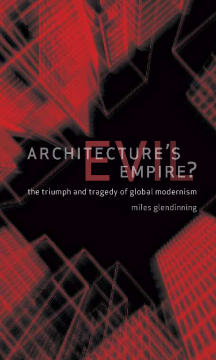
Additional Information
Book Details
Abstract
From Chicago to Toronto to Shanghai, cities around the world have sprouted “iconic” buildings by celebrity architects like Frank Gehry and Daniel Libeskind that compete for attention both on the skyline and in the media. But in recent years, criticism of these extreme “gestural” structures, known for their often-exaggerated forms, has been growing. Miles Glendinning’s impassioned polemic, Architecture’s Evil Empire, looks at how today’s trademark architectural individualism stretches beyond the well-known works and ultimately extends to the entire built environment. Glendinning examines how the global empire of the current modernism emerged—particularly in relation to the excesses of global capitalism—and explains its key organizational and architectural features, placing its most influential theorists and designers in a broader context of history and artistic movements.
Arguing against the excesses of iconic architecture, Glendinning advocates a vision of modern renewal that seeks to remedy the shattered and alienated look he sees in contemporary architecture. Mingling scholarship with wry humor and a genuine concern for the state of architecture, Architecture’s Evil Empire will raise many heated debates and appeal to a wide range of readers, from architects to historians, interested in the built environment.
"One of the effects of our brand-led and time-starved world is that whatever cultural endeavour you choose to undertake: staging an art exhibition; hosting a club night; or commissioning a building of a new skyscraper, people only seem to notice if there is a big named involved. Consequently, architecture has seen a rise in celebrity 'Starchitects.' This handful of names is often given carte blanche to dump masses of concrete and steel in conceptual yet dysfunctional heaps around the world with scant regard for the cultural mores of the folk who live there. The trend for such gestural constructs is finally and rightly challenged here in this wry and passionate polemic addressing the state of contemporary architecture. An unsettling book for some, but of interest to all."
— Bookseller"Engrossing . . . Glendinning's polemic argues that the 'spectacularisation' of architecture creates alienated places and people. Late 20th-century modernist architecture's failure to give form to a humane socio-industrial revolution collapsed in the 1980s and 1990s into a veneration of inherently capitalist design geniuses. Their arbitrarily flamboyant buildings have little social or historical integrity. Glendinning marshals his arguments deftly and his quoted material burns bright . . . admirable."–Independent
— Independent"In Architecture’s Evil Empire?, Glendinning is . . . concerned with what has been done in the name of regeneration. But, rather than looking at generic housing and malls, he concerns himself with the recent phenomenon of civic “boosterism”, by which towns and cities draw attention to themselves through look-at-me cultural buildings. The emergence of the “starchitect” has turned traditionally socially conscious modernism down the blind alley of personal expression. Glendinning traces the problems from that proto-icon the Sydney Opera House, through Frank Gehry’s Guggenheim Museum in Bilbao, and onward." — Edwin Heathcote, Financial Times
“Miles Glendinning’s book hits the spot . . . like all effective polemics this one turns swift and stylish, and comes to a positive conclusion: rebuild your cities slowly and carefully; integrate into them what was good about what was there before; remember that buildings are supposed to dignify people; shut up and stop showing off.”
— Architecture Today“Glendinning marshals his arguments deftly and his quoted material burns bright . . . It’s not architectural icons that Glendinning fears most, but the hidden iceberg of decadent causes and effects on which they perch.”
— Jay Merrick, Sunday Tribune (Ireland)Miles Glendinning a reader in the School of Architecture at the Edinburgh College of Art and director of the Scottish Centre for Conservation Studies. He is the author and co-author of many books, including Tower Block: Modern Public Housing in England, Scotland, Wales and Northern Ireland, Clone City: Crisis and Renewal in Contemporary Scottish Architecture, The Last Icons and Modern Architect: The Life and Times of Robert Matthew.
